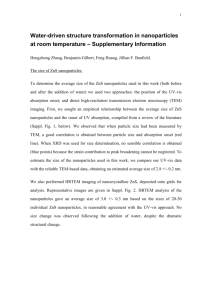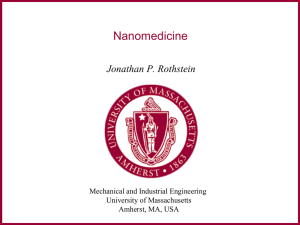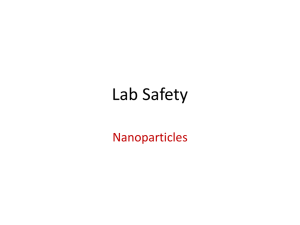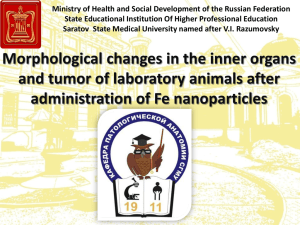Experimental section and analytical data.
advertisement
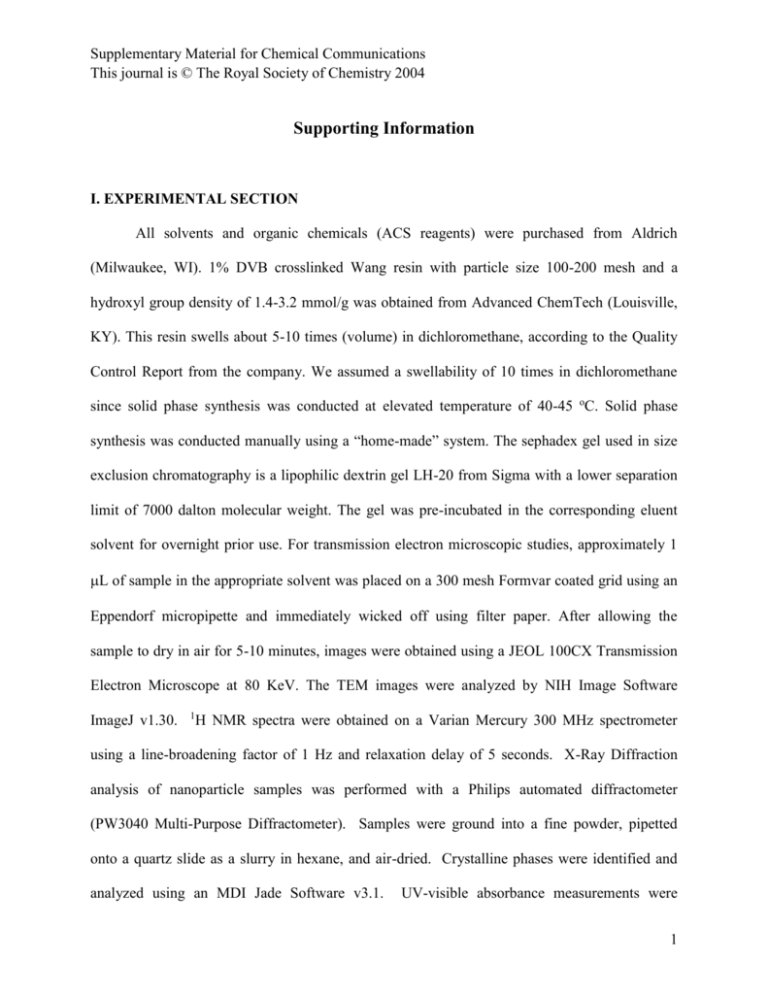
Supplementary Material for Chemical Communications This journal is © The Royal Society of Chemistry 2004 Supporting Information I. EXPERIMENTAL SECTION All solvents and organic chemicals (ACS reagents) were purchased from Aldrich (Milwaukee, WI). 1% DVB crosslinked Wang resin with particle size 100-200 mesh and a hydroxyl group density of 1.4-3.2 mmol/g was obtained from Advanced ChemTech (Louisville, KY). This resin swells about 5-10 times (volume) in dichloromethane, according to the Quality Control Report from the company. We assumed a swellability of 10 times in dichloromethane since solid phase synthesis was conducted at elevated temperature of 40-45 oC. Solid phase synthesis was conducted manually using a “home-made” system. The sephadex gel used in size exclusion chromatography is a lipophilic dextrin gel LH-20 from Sigma with a lower separation limit of 7000 dalton molecular weight. The gel was pre-incubated in the corresponding eluent solvent for overnight prior use. For transmission electron microscopic studies, approximately 1 L of sample in the appropriate solvent was placed on a 300 mesh Formvar coated grid using an Eppendorf micropipette and immediately wicked off using filter paper. After allowing the sample to dry in air for 5-10 minutes, images were obtained using a JEOL 100CX Transmission Electron Microscope at 80 KeV. The TEM images were analyzed by NIH Image Software ImageJ v1.30. 1 H NMR spectra were obtained on a Varian Mercury 300 MHz spectrometer using a line-broadening factor of 1 Hz and relaxation delay of 5 seconds. X-Ray Diffraction analysis of nanoparticle samples was performed with a Philips automated diffractometer (PW3040 Multi-Purpose Diffractometer). Samples were ground into a fine powder, pipetted onto a quartz slide as a slurry in hexane, and air-dried. Crystalline phases were identified and analyzed using an MDI Jade Software v3.1. UV-visible absorbance measurements were 1 Supplementary Material for Chemical Communications This journal is © The Royal Society of Chemistry 2004 acquired using an Agilent 8453 Spectrometer with a solvent mixture of 4:1 dichloromethane to methanol. 1. Solid phase synthesis of BtAu-COOH nanoparticles Acetyl-protected 6-mercaptohexanoic acid was prepared according to literature procedure16 and coupled to Wang resin in 1:2 mole ratio (thiol:hydroxyl group) using standard loading procedure for attaching amino acids to Wang resin.12,13 After washing with DMF, dichloromethane and methanol followed by drying, the acetyl group was deprotected using ammonia solution (3 M in dioxane/water, 4/1, v/v) for 12-24 hours. Ellman’s agent (5,5’-dithiobisnitrobenzoic acid) was used to monitor the deprotection of the acetyl group visually. After the washing/drying cycle again, dichloromethane solution of BtAu nanoparticles (30 mg in 6 mL CH2Cl2, prepared according to the reported Schiffrin reaction using 1:1 mole ratio of HAuCl 4 and butanethiol at room temperature) was added and mixed with solid resin. The exchange reaction was allowed to proceed for four hours at 45 oC followed by twelve hours at room temperature with gentle shaking. During this time the beads turned dark black. After filtering and washing with warm dichloromethane, the dark beads were dried under vacuum and then suspended in dichloromethane (8 mL) for thirty minutes. The nanoparticles were then cleaved from the resin by adding 2.0 mL trifluoroacetic acid (equivalent to 20% TFA in CH2Cl2) and shaking the beads at room temperature for four hours. The dark nanoparticle solution was then collected and the nanoparticles were recovered by blowing off the solvent using a stream of N2 gas. The crude product was further purified by the following procedure. The dark solids were washed with petroleum ether 15-20 times with occasional sonication followed by centrifugation. After each cycle, the washing solution was tested for organic impurities by thin layer 2 Supplementary Material for Chemical Communications This journal is © The Royal Society of Chemistry 2004 chromatography. The washing cycle was repeated until there was no longer UV active species appeared on the TLC plates and the washing solution became almost neutral. After drying, the nanoparticles were re-dissolved in a mixed solvent of 9:1 dichloromethane and methanol, and purified by size exclusion chromatography. The dark nanoparticle sample was collected in one portion. The sample was blown dry with N2 stream and washed two additional times with petroleum ether and dried. The washing solution was found neutral (pH =7) and NMR analysis confirmed that the nanoparticle product was free of small organic molecules. The total yield of the purified BtAu-COOH nanoparticle is around 50%. XRD analysis of the BtAu nanoparticles indicates that the nanoparticles have a core diameter of 1.84nm relative to the 111 reflection and 1.57nm relative to the 200 reflection. This core diameter corresponds to a nanoparticle diameter of 2.8 nm, in good agreement with the TEM analysis results. The different core sizes may indicate that the nanoparticles have more than one crystal structures. The X-ray diffraction pattern of the BtAu nanoparticles is attached. 2. Calculation of the thiol group density on the Wang Resin during solid phase synthesis. Advanced ChemTech Handbook of Combinatorial & Solid Phase Organic Chemistry, 1998, Adcanced ChemTech, Inc., page 100-101. The Wang resin (1% DVB crosslinked polystyrene) used in this study has a functionality (-OH group) of 1.4-3.2 mmol/g and density of 1.05 grams/cm3. This resin swells about 5-10 times of its dry volume in CH2Cl2. A swellability of 10 times was used for the calculation, since the solid phase place exchange reaction was conducted at 40-45 oC. According to these numbers, it is calculated that there is approximately one hydroxyl group per 10 nm3 in CH2Cl2 solution. Since only 0.5 equivalent of 6- 3 Supplementary Material for Chemical Communications This journal is © The Royal Society of Chemistry 2004 mercaptohexanoic acid was loaded to Wang resin, there should be less than one thiol group per 20 nm3 attached to the resin for the solid phase place exchange reaction. 3. Coupling reaction of BtAu-COOH nanoparticles with 1,7-diaminoheptane To couple BtAu-COOH nanoparticles with 1,7-diaminohetane, approximately 5 mg dried BtAu-COOH nanoparticles were dissolved in 400 L dichloromethane and 100 L DMF. To this solution, approximately 500 times equivalent of N-hydroxysuccinimide in 100 L DMF was added followed by 500 times equivalent of 1-[3-(dimethylamino)propyl]-3-ethylcarbodiimide hydrochloride (EDC) in 100 L DMF. The reaction mixture was incubated at 40 oC water bath for 4 hours followed by gentle shaking at room temperature for overnight. After blowing off most of the solvent, the reaction mixture was run through size exclusion chromatography to eliminate excessive organic reagents. The collected nanoparticle solution was concentrated by gentle nitrogen gas flow again. Typically, almost all the nanoparticles were re-collected after the activation reaction. The activated nanoparticles were re-dissolved in 500 L dichloromethane and to the solution, approximately 100 times equivalent of 1,7-diaminoheptane was added and the reaction mixture was allowed to shake at room temperature for 24 hours. After blowing off the excessive solvent, the reaction mixture was purified by size exclusion chromatography to eliminate small organic reagent. The collected nanoparticle samples were subjected to TEM analysis by re-dissolving them in dichloromethane to the appropriate concentration. 4. Place exchange reaction to prepare 5% and 40% 11-mercaptoundecanoic acid substituted BtAu nanoparticles: BtAu-COOH5% and BtAu-COOH40% (Refer to reference 6: Langmuir 1999, 15, 3782-3789) 4 Supplementary Material for Chemical Communications This journal is © The Royal Society of Chemistry 2004 a. Synthesis of BtAu-COOH5% Approximately 70 mg BtAu nanoparticles were dissolved in 25 mL toluene. To this solution, ~1.30 mg of 11-mercaptoundecanoic acid was added to give a 1:20 molar ratio of incoming thiol ligand versus the nanoparticle-bound thiolate. This reaction mixture, protected by N2, was stirred between 48 and 96 hours for complete place exchange reaction to occur. After the reaction the solvent was removed using a rotary evaporator. The dark solid product was resuspended in acetonitrile and washed by centrifugation for adequate times until no small organic species were found in the washing solution by TLC and NMR analysis. b. Synthesis of BtAu-COOH40% The 40% place exchange product was obtained in a similar procedure except that a 1:2 molar ratio of 11-mercaptoundecanoic acid to the nanoparticle-bound thiolate was used for the place exchange reaction. The product was re-suspended, filtered and washed with adequate acetonitrile to eliminate any small organic residues. c. Coupling reaction of 5% and 40% place exchanged product with 1,7-diaminoheptane The diamine coupling reaction was conducted using a similar condition as the coupling of BtAu-COOH nanoparticles by 1,7-diaminoheptane. After the coupling reaction, it was found that a large amount of precipitates appeared from the 40% place exchange sample. These precipitates were collected and rinsed with dichloromethane, mixed dichloromethane/methanol, and methanol, alternatively. The precipitates were found insoluble in most organic solvents. For this reason, TEM analysis was not conducted on this sample. The 5% place exchange sample remains as a solution after coupling reaction, although a very small amount of precipitates was also formed. After blowing off most of the solvent, the reaction mixture was purified by size 5 Supplementary Material for Chemical Communications This journal is © The Royal Society of Chemistry 2004 exclusion chromatography to eliminate small organic molecules. The collected sample was then dissolved in dichloromethane to appropriate concentration for TEM analysis. II. ANALYSIS DATA 1. XRD pattern of BtAu sample 6 Supplementary Material for Chemical Communications This journal is © The Royal Society of Chemistry 2004 2. TEM image of BtAu (300,000x) 7 Supplementary Material for Chemical Communications This journal is © The Royal Society of Chemistry 2004 3. TEM image of BtAu-COOH (300,000x) 8 Supplementary Material for Chemical Communications This journal is © The Royal Society of Chemistry 2004 4. TEM image of 1,7-diaminoheptane coupled BtAu-COOH-DAH (300,000x) 9 Supplementary Material for Chemical Communications This journal is © The Royal Society of Chemistry 2004 5. TEM image of 1,7-diaminoheptane coupled BtAu-COOH-DAH from a different sample (300,000x) 10 Supplementary Material for Chemical Communications This journal is © The Royal Society of Chemistry 2004 6. UV-visible Absorbance Spectra of the BtAu and the BtAu-COOHDAH Nanoparticles 0.8 0.7 Absorbance 0.6 0.5 BtAu 0.4 BtAu-COOH-DAH 0.3 0.2 0.1 0 300 400 500 600 700 800 900 1000 1100 Wavelength (nm) 11 Supplementary Material for Chemical Communications This journal is © The Royal Society of Chemistry 2004 6. TEM image of 1,7-diaminoheptane coupled 5% place exchange product BtAu-COOH5% 300,000x 12 Supplementary Material for Chemical Communications This journal is © The Royal Society of Chemistry 2004 13




